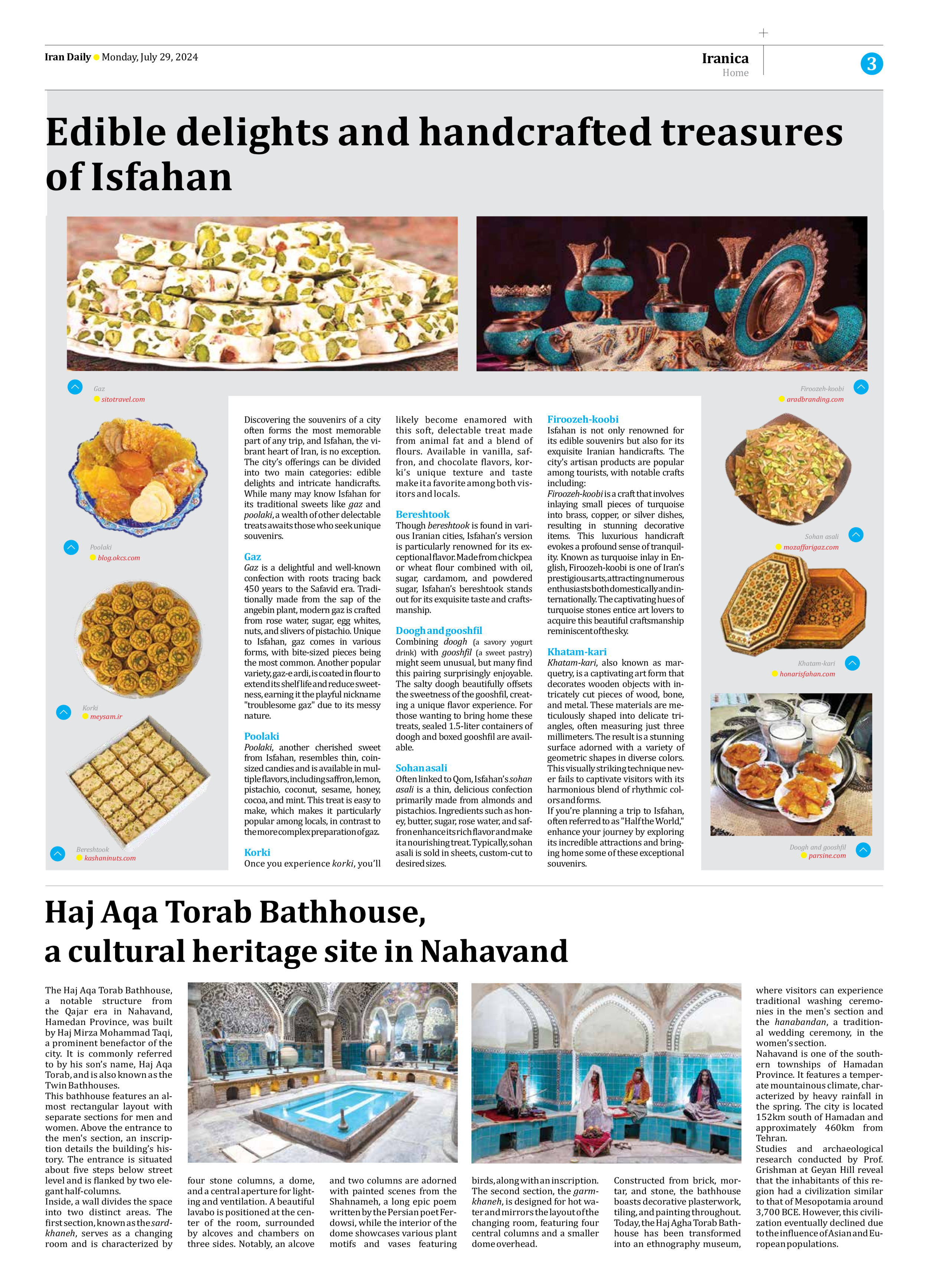
Edible delights and handcrafted treasures of Isfahan
Discovering the souvenirs of a city often forms the most memorable part of any trip, and Isfahan, the vibrant heart of Iran, is no exception. The city’s offerings can be divided into two main categories: edible delights and intricate handicrafts. While many may know Isfahan for its traditional sweets like gaz and poolaki, a wealth of other delectable treats awaits those who seek unique souvenirs.
Gaz
Gaz is a delightful and well-known confection with roots tracing back 450 years to the Safavid era. Traditionally made from the sap of the angebin plant, modern gaz is crafted from rose water, sugar, egg whites, nuts, and slivers of pistachio. Unique to Isfahan, gaz comes in various forms, with bite-sized pieces being the most common. Another popular variety, gaz-e ardi, is coated in flour to extend its shelf life and reduce sweetness, earning it the playful nickname "troublesome gaz" due to its messy nature.
Poolaki
Poolaki, another cherished sweet from Isfahan, resembles thin, coin-sized candies and is available in multiple flavors, including saffron, lemon, pistachio, coconut, sesame, honey, cocoa, and mint. This treat is easy to make, which makes it particularly popular among locals, in contrast to the more complex preparation of gaz.
Korki
Once you experience korki, you’ll likely become enamored with this soft, delectable treat made from animal fat and a blend of flours. Available in vanilla, saffron, and chocolate flavors, korki’s unique texture and taste make it a favorite among both visitors and locals.
Bereshtook
Though bereshtook is found in various Iranian cities, Isfahan’s version is particularly renowned for its exceptional flavor. Made from chickpea or wheat flour combined with oil, sugar, cardamom, and powdered sugar, Isfahan’s bereshtook stands out for its exquisite taste and craftsmanship.
Doogh and gooshfil
Combining doogh (a savory yogurt drink) with gooshfil (a sweet pastry) might seem unusual, but many find this pairing surprisingly enjoyable. The salty doogh beautifully offsets the sweetness of the gooshfil, creating a unique flavor experience. For those wanting to bring home these treats, sealed 1.5-liter containers of doogh and boxed gooshfil are available.
Sohan asali
Often linked to Qom, Isfahan’s sohan asali is a thin, delicious confection primarily made from almonds and pistachios. Ingredients such as honey, butter, sugar, rose water, and saffron enhance its rich flavor and make it a nourishing treat. Typically, sohan asali is sold in sheets, custom-cut to desired sizes.
Firoozeh-koobi
Isfahan is not only renowned for its edible souvenirs but also for its exquisite Iranian handicrafts. The city's artisan products are popular among tourists, with notable crafts including:
Firoozeh-koobi is a craft that involves inlaying small pieces of turquoise into brass, copper, or silver dishes, resulting in stunning decorative items. This luxurious handicraft evokes a profound sense of tranquility. Known as turquoise inlay in English, Firoozeh-koobi is one of Iran’s prestigious arts, attracting numerous enthusiasts both domestically and internationally. The captivating hues of turquoise stones entice art lovers to acquire this beautiful craftsmanship reminiscent of the sky.
Khatam-kari
Khatam-kari, also known as marquetry, is a captivating art form that decorates wooden objects with intricately cut pieces of wood, bone, and metal. These materials are meticulously shaped into delicate triangles, often measuring just three millimeters. The result is a stunning surface adorned with a variety of geometric shapes in diverse colors. This visually striking technique never fails to captivate visitors with its harmonious blend of rhythmic colors and forms.
If you’re planning a trip to Isfahan, often referred to as "Half the World," enhance your journey by exploring its incredible attractions and bringing home some of these exceptional souvenirs.







